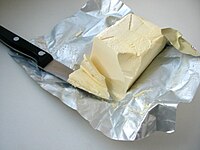
Photo from wikipedia
Lard with a substantially reduced cholesterol content through aqueous enzyme extraction is an attractive source of lipid in healthy and nutritious emulsion food product development. The objective of this study… Click to show full abstract
Lard with a substantially reduced cholesterol content through aqueous enzyme extraction is an attractive source of lipid in healthy and nutritious emulsion food product development. The objective of this study was to elucidate the crystallization behavior (4-20 °C) of emulsions prepared from low-cholesterol lard in relation to protein emulsifier (2 and 4% whey protein isolate, WPI) and ultrasound (475 w, 5 min) treatments. The physicochemical properties and fat crystallization pattern of the emulsions were investigated. Emulsions with 4% WPI were superior to those with 2% WPI on interfacial adsorption and crystal size reduction. Ultrasonic treatment of prepared emulsions further decreased fat crystal size, promoted small and uniform crystal distribution, and slightly destabilized emulsions. Protein concentration and ultrasonic treatment had no obvious effect on crystal transition from β' to the more stable β-form based on X-ray diffraction. The melting properties determined by differential scanning calorimetry indicated that emulsified lard had a lower onset melting temperature than bulk lard, and with ultrasound treatment, the melting enthalpy increased remarkably. The ultrasound-induced change in fat crystalline structure and emulsion meta-stability may be valuable to the manufacture of healthy, emulsion-incorporated food products.
Journal Title: Ultrasonics sonochemistry
Year Published: 2019
Link to full text (if available)
Share on Social Media: Sign Up to like & get
recommendations!